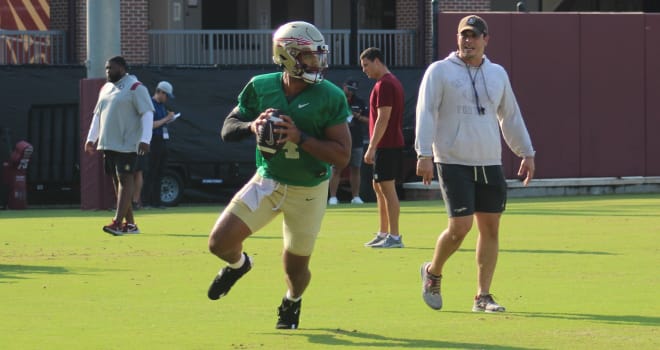Helmet communication reinforces learning from FSU coaches to QB, LB

Mike Norvell has the chance to be in a quarterback’s ear before every play in practice. There’s also a fine line of not saying too much.
“We do use it every day,” Florida State's coach said. “Making sure that we can be as efficient as we can be and also getting the quality of information during that period of time and not be overwhelming.”
Norvell is often running around FSU’s practice field and has a walkie-talkie in his hand to use as a one-way, sideline-to-helmet communication tool. The NCAA approved the measure this spring for college football, introducing what has been a presence in the NFL since 1994.
FSU has experimented with the communication since the spring, with a green dot on specific helmets that quarterbacks and linebackers can wear (only one linebacker per play can have the green-dot helmet). Norvell talks with the quarterbacks, while defensive coordinator Adam Fuller communicates with the linebackers.
A coach can talk to a quarterback or linebacker before a play but the communication cuts off with 15 seconds left on the play clock.
“If there's a quick blast of information that they can get, or just a quick tip or something like that, it's definitely useful,” quarterbacks coach Tony Tokarz said. “But there's also that fine line for us to balance as coaches. We want to try and give them a bunch (of information), but at the same time, you've got to realize they have to go out and play, too.
“So you don't want to paralyze them a little bit by too much. But I think we've done a good job balancing that and the quarterbacks have definitely taken to it."
Norvell was shown on an episode of The Climb in April talking with FSU's quarterbacks:
Tokarz acknowledged that the helmet communication can help younger quarterbacks like Brock Glenn and Luke Kromenhoek because “you want to help them a little bit more.”
Fuller said FSU’s defense used the communication with a linebacker more in the second scrimmage. In the first scrimmage, they often had two linebackers on the field with green-dot helmets as coaches were trying out different rotations. Especially on defense, the equipment staff is more involved to make sure a linebacker who is subbing in has the green-dot helmet.
Fuller recalled a pre-snap situation where the defensive alignment in a scrimmage “wasn’t the way we wanted.” He was quickly able to communicate to the linebacker and “execute it the way we wanted to execute.”
The technology further emphasizes the importance of the quarterback and the primary linebacker as communicators to the other 10 Seminoles on the field.
“You have to start with whoever has the dot basically becomes the voice of the defense,” Fuller said. “And guys have to understand that’s not a suggestion.”
Sign up for the Osceola's free daily email newsletters
Follow The Osceola on Facebook
Follow The Osceola on Twitter
Subscribe to the Osceola's YouTube channel
Subscribe to the Osceola's podcasts on Apple
